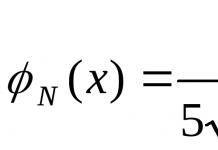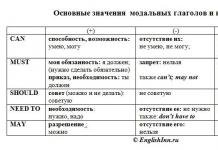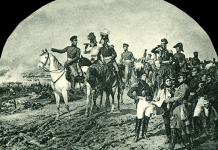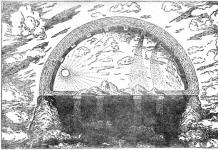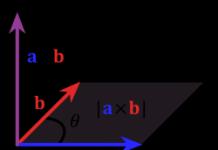The foundation for building a tree of organizational goals is the classic hierarchical structure of the company.
Classic hierarchical The structure of the organization implies a clear delineation of duties and areas of responsibility.
This structure has many advantages:
- Ease of Management: managers give instructions only to a certain number of people
- Resistance to staff turnover: business processes are tied to specific positions, and not to specific employees
- High staff efficiency: Each employee participates in a strictly limited number of processes, therefore has the opportunity to speed up the completion of tasks due to their repeatability
Why tree goals are needed
The company's goals can be written in the form of a single-level list.
Such an organization has the following disadvantages:
- Lack of consistency in achieving goals.
Let's say that in order to achieve goal A, you must first achieve goal B. This determines the correct order of actions: B ⟶ A. It is difficult to see such dependencies in a linear list. - Difficulty determining the importance of each goal.
A situation may arise where, due to lack of resources, some goals will need to be sacrificed. In this case, it will be difficult to determine which goals are critical and which are not, hence the possibility of removing a truly important goal from the list. Irregularity in achieving goals. - Goals are achieved at various intervals.
For example, the first goal on the list was achieved in 5 days, the second in 8 days, and the employees have been working on the third for 2 months, and the work has not yet been completed. This can lead to decreased employee enthusiasm and the spread of depressive attitudes.
To avoid the mentioned disadvantages, a tree of organizational goals is used. It is a hierarchical list of goals indicating responsible and planned expenditure of resources (time, money, etc.)
How to build a tree of organizational goals
Step 1.
The main goal for a specific period is determined: month, quarter or year
The main goal should be formulated by the director of the organization. This goal is located at the first level of the list (at the top).
Step 2.
Second level goals are determined
The director of the organization convenes a meeting of department heads. For example, the following may participate in the council: deputy director, commercial director, branch director. 3-5 goals are generated, the achievement of which will automatically lead to the realization of the main goal. Each department is assigned one or two goals.

Step 3.
Third level goals are determined
Each of the department heads organizes a planning meeting for the directors of the departments under their subordination. Goals are generated at the planning meeting, which will allow achieving the department's goals. Each department director is assigned a list of goals.

Step 4.
The goals of the fourth level are determined
Department heads put together planning meetings for employees. Further actions are performed by analogy.
Step 5.
A tree of organizational goals is formed
All goals are collected into a single structure. It can be located on large sheets of paper, a magnetic marker board, or in a planning program.
Programs for building a tree of organizational goals
It is important to understand that projects play a key role in the structure of the tree of enterprise goals. The project goal tree is built on a similar principle to its “big brother”.
But what will help us create a tree of company goals? And at the same time, distribute all responsibilities evenly among employees.
Of all the media listed above, programs are the most convenient. They allow you to quickly make changes to the goal tree, inform employees about changes and limit the circle of people who have access to the tree.
Try the program LeaderTask- one of the most famous programs for creating a tree of goals and monitoring implementation. The trees in the illustrations were compiled in LeaderTask.
Creating a goal tree online is a direct solution to the paper-based bureaucratic problem of an organization of any caliber. Whether it is a small company or a huge concern. Hence the main benefit of using LeaderTask.
And the last thing I would like to talk about is planning. After all, every successful entrepreneur has heard about this phrase a couple of times, but they just couldn’t find the right tool. We hasten to reassure you: strategic planning, tree of goals are synonymous words. Compose it right now in LeaderTask.
Through the achievement of life goals, the meaning of a person’s life is determined, the same can be said about the existence of every company, be it state-owned, charitable, public or commercial, tree of organizational goals - a simple example. Any enterprise, individual entrepreneur or association pursues its own goals, which are the reason for their functioning and existence. Let's consider different kinds tasks and, using the example of a company, we will build an example of a tree of goals.
Purpose and mission
Each enterprise, in the process of work, develops its own mission - the main task that justifies the existence of the organization. For example, for a charity company it is helping people with cancer. For a commercial company - to earn maximum profit, for a social organization - to achieve a significant social task, for example, adaptation to modern world disabled children.
The process of achieving the mission will be divided into goals, “steps”, by overcoming which you can get as close as possible to solving the main task.
Types of goals
Any company for the near future sets for itself several aspirations and desires, which can be long-term, medium-term and short-term. It usually takes no more than 12 months to solve a short-term goal, medium-term ones - from one year to five to six years, and at least 5 years are required to solve a long-term problem.
How goals are set
In general, goals for the entire organization or for each of its divisions are set by the center, or decentralized and centralized by department heads. It all depends on what management system is adopted at the enterprise.
The decentralized method of goal setting can develop in two directions. In the first method, bottom-up, goals are initially set in departments, and management, based on them, determines the main tasks of the organization and ways to solve them. In the second method - from top to bottom, large tasks are set by the center, and managers, in order to solve them, locally develop smaller goals and set them for staff and workers.
A task tree using the example of a company is compiled based on an analysis of the impact of the external and internal environment at the enterprise, adhering to the main goal of the organization. And only then are individual and specific goals set.
Tree of goals using the example of an organization
Viewing an example of a goal tree in a graphical display helps to visualize the model of the organization's goals. It makes it easy to organize the importance of tasks. To construct such a graph, there are conditional positions.
The overall mission (goal) of the company is placed at the top of the tree. Then it is divided into separate subtasks, without which the main task cannot be completed. When formulating a task, it is necessary to describe the desired result, but it is not necessary to indicate the method for achieving it. Goals should be on the same level, not resulting from each other and independent of each other.
Each organization has a unique set of goals. However, several areas of activity can be distinguished; any company will find its interest in them:
Production
Personnel Policy
Finance and politics
Sales Policy
The number of levels into which the organization's main task is divided depends on the complexity of the goal, the size of the company, the hierarchy in management and organizational structure.
An example of a tree of organizational goals:

Examples of specific organizational objectives
IN different areas activities, the organization has its own goals, let's consider some of them.
Marketing
Expansion of product range
Market promotion
Production
Development and implementation modern technologies
Improving product competitiveness
Improved production efficiency
Cost reduction
Staff
Increased productivity
Incentive system
HR optimization
Training
Example of an organization's goal tree No. 2:

Finance
Multiplying investment attractiveness
Improved profitability and solvency
Effective financial management of the organization
Setting goals for an organization has great importance, is the basis for building relationships within the organization, and only by solving the assigned tasks can one evaluate and keep under control the progress and results of the work of departments, personnel and the entire structure as a whole.
An example of goal-oriented control is control based on a tree-like open graph that has no cycles, i.e. closed goals. In practice, graphs called “goal trees” are used.
The goal tree is graphic image connections between goals and means of achieving them, built on the principle of deductive logic and using heuristic procedures.
The goal tree helps to present a complete picture of the interrelations of future events, up to obtaining a list of specific tasks and obtain information about their importance. It ensures the work of bringing goals to the immediate executors by building a correspondence between the organizational management structure and the structure of goals.
The idea of a “goal tree” was first proposed by C. West Churchman in connection with decision-making problems in industry and is based on obtaining hierarchical structures by sequentially dividing an overall goal into subgoals, subgoals into functions, and functions into more detailed functions.
The procedure for forming a tree of goals is largely an approximate process and little formalized due to the difficulties of identifying goals.
The tree of organizational goals contains both a description of the goals and the relationships between them. Within the framework of this model, hierarchical “goal-means” relationships are established between its elements, suggesting that the achievement of each lower goal becomes one of the means to achieve the higher one.
The rules for constructing a goal tree are very simple: the main goal must be the top of the tree. Branches become local goals that help achieve top-level goals. The main rule is the completeness of the described goals. Each goal should be presented in the form of subgoals of the next level (Fig. 2).
Rice. 2.
Thus, the unification of all goals should fully characterize the main, general goal.
The basis for constructing the top of the goal tree is a set of strategic goals defined within the framework of the organization's strategy. Strategically significant should be recognized not only those goals that determine the direction strategic development, but also long-term goals related to maintaining the functioning of the management system and subsystems related to production and supply.
Achievement of strategic goals is ensured by the achievement of both operational (regular, permanently achieved) goals and project (unique in content) goals.
Goals must be carefully classified and appropriately structured within the framework of diagrams, diagrams - in such a way that they become presentable and as understandable as possible for their reader.
The type of goal tree depends on how complex and multi-level the process of implementing the plans will be. Targets can be trajectory or point. Trajectory, or, as they are also called, guides, determine the general direction in which the state of the controlled object should change. For example, the goal of “increasing the profit of the enterprise” is only the direction in which the organization seeks to change the profit received by the enterprise. At the same time, targeted goals are formulated as the desire to achieve a very specific result (for example, to ensure a profit for the enterprise in the current year in the amount of 7.5 million rubles).
There may be different goals hierarchical levels. If the goal of the 0th level is considered a general goal, for example, “ensuring the production of competitive products,” then the goals of the 1st level can be “restructuring production,” “introducing a new technological line,” “improving the qualifications of specialists,” “changing the material system.” employee incentives" etc.
The main value of constructing a tree of goals is to display the way to achieve the general goal by justifying a hierarchical list of understandable and achievable goals of lower levels.
Goal tree- is structured, built according to hierarchical principle(distributed by levels, ranked) set of system goals, in which the general goal (“top of the tree”) is highlighted; subgoals of the first, second and subsequent levels (“tree branches”) subordinate to it.
The term "tree" implies the use hierarchical structure(from oldest to youngest), obtained by dividing the overall goal into subgoals. The principle of breaking the overall goal into subgoals and tasks is illustrated by the diagram presented in Figure 14 (p. 36).
The name “goal tree” is due to the fact that the schematically presented set of goals distributed across levels resembles an inverted tree in appearance. The concept of a "goal tree" was first proposed Charles Churchman 8 And Russell Ackoff 9 in 1957 year. It allows a person to put his own plans in order and see his goals in the group. No matter whether they are personal or professional. In particular, the goal tree allows you to identify what possible combinations will provide the best return.
Figure 14. Breakdown of goals into subgoals and tasks: I-V - levels of the system; 1-39 - system elements.
Goal tree method focused on obtaining a relatively stable structure of goals, problems, and directions. This method is widely used for forecastingpossible directions development of science, technology, technology, as well as for drawing up personal, professional, and goals of any company.
The tree of goals closely links long-term goals and specific tasks at each level of the hierarchy. At the same time, the goal higher order corresponds to the top of the tree, and below, in several tiers, local goals (tasks) are located, with the help of which the achievement of the goals of the top level is ensured.
One of basic principles for constructing a goal tree– each goal of a given level must be presented in the form of subgoals of the next level in such a way that their totality completely defines the concept of the original goal. The exclusion of at least one subgoal deprives completeness or changes the very concept of the original goal.
Stages of building a goal tree:
1. Formulation of the strategic goal. This is the top of the tree, it can also be global large and very difficult goal, in contrast to the strategic one, in the possibility of its ultimate achievability. (example, strategic - increase sales, global - increase capital in a certain amount; strategic - personal growth, global - learn 5 foreign languages). This goal answers the questions: what do I (we, the organization) want to receive or receive after such and such a period? Who I want to be? What do we want to achieve or achieve? The answer is we write it to the vertex.
2. Write down the conditions, subgoals contributing to the implementation of the global strategic goal. Answering the questions: under what conditions is it possible to achieve the goal? What tasks or goals need to be solved to achieve goal number 1?
3. We split the goal further, do the same procedure as in the case in point 2, but only in relation to 2nd row of targets. Our task is to build a consistent hierarchy until all goals are reduced to the implementation of a specific small task, either completed once, or in a constant cycle.
You need to break down your goals sequentially. Those. they had to be subordinate to each other, and there were no big jumps.
The smallest goals should be as simple as possible, the implementation of which realizes, just as simply, a higher goal.
When expanding a goal into a hierarchical structure of goals, it is assumed that the implementation of subgoals (tasks) of each subsequent level is a necessary and sufficient condition for achieving the goal of the previous level.
When formulating goals at various levels, it is necessary to describe the desired results, but not the methods for obtaining them.
The subgoals of each level should be independent of each other and not emanating from each other.
The foundation of the goal tree combines tasks, which are the formulation of work that is performed in a certain way and within a predetermined time frame.
The overall goal, located at the top of the graph, must contain a description of the final result.

The number of levels of decomposition depends on the scale and complexity of the goals set, and on the structure adopted in the organization.
Let's look at examples of the key goals of an enterprise.

A goal tree can be compiled for any goal: global, monthly, annual.
An example of creating a goal tree. The goal is to become a university student.
Resources: good education (specialized school, tutors), wealthy parents, etc.
The probability assessment is high: a gold medal, my uncle is a teacher at this university, etc.
1. Continue additional education and tutoring, get a job (save money), talk to the bank about a loan, etc.
2. Talk to your uncle about help, go to preparatory courses, etc.
Subgoals can give rise to smaller goals, etc.
Send your good work in the knowledge base is simple. Use the form below
Students, graduate students, young scientists who use the knowledge base in their studies and work will be very grateful to you.
Posted on http://www.allbest.ru/
Federal State Budgetary Educational Institution
higher professional education
"Velikoluksk State Academy
physical culture and sports"
Department of Humanitarian and Socio-Economic Disciplines
Course work
Tree of goals in the organization
Prepared by a student of group 28
social and humanitarian
faculty
Nikulina Irina Vasilievna
Checked
n.e.p. Stepanov A.A.
Velikiye Luki, 2015
Introduction
1.1 The concept of "goal"
2.1 Requirements for building a goal tree
2.3 Building a tree of organizational goals using the example of Apple
Conclusion
Bibliography
Applications
Introduction
A goal is the desired state of the system or the result of its activity, achievable within a certain time interval. The goals should reflect the development perspective of the system. The goals of the activities of socio-economic systems are largely determined by the conditions external environment.
The process of setting goals is a very important factor on the path to success. The goal of an organization does not arise only because it needs to have guidelines so as not to perish in a changing environment. First of all, the goal arises because an organization is an association of people pursuing certain goals.
In an organizational management system with a hierarchical structure, the goals of subsystems at different levels are examined and formed in accordance with the functions they perform. At the same time, the set of goals of subsystems of one level must ensure the fulfillment of the goal of that subsystem for more than high level, to which they are subordinate. A set of successively fragmented goals in accordance with the decreasing level of subsystems is called a goal tree. Thus, the goals of individual subsystems are linked into the goal tree diagram, which is a visual graphical model of the hierarchical relationship of the goals of the system as a whole and its individual subsystems.
For an organization, the process of setting goals is a very important factor on the path to success. The goal principle in the activities of an organization does not arise only because it needs to have guidelines so as not to perish in a changing environment. First of all, the goal principle in the activities of an organization arises because an organization is an association of people pursuing certain goals. When we're talking about about the target principle in the behavior of the organization and, accordingly, about the target principle in the management of the organization, then we usually talk about two components: mission and goals. Establishing both, as well as developing a behavioral strategy that ensures the fulfillment of the mission and the achievement of the organization's goals, is one of the main tasks of top management and, accordingly, forms a very important part of strategic management. Determining the purpose of a system is one of the most important, complex and difficult to resolve issues. Its importance is beyond doubt - an incorrect or insufficiently clear definition of the goal leads to very serious consequences for the system as a whole, dooming it to “blindly” wandering in dynamically changing environmental conditions.
Any management system, by definition, is a goal-oriented system that has a hierarchical structure and is organized to achieve goals called the goals of the management system.
One of the methods used to improve the management of an organization is the “tree of goals”, which is what is to be considered in this work.
My goal course work is to explore the concept and construction of a goal tree.
To achieve this goal, it is necessary to solve the following tasks:
1. reveal the concept of goal
2. reveal the concept of the “tree of goals” of the organization
3. consider the process of constructing a tree of goals.
The object of study of the course work is the “goal tree” method.
The subject of the study is the construction of a “goal tree”.
The theoretical basis for the work was provided by textbooks on the study of control systems.
Chapter 1. The concept of “goal tree” and the theory of the method
1.1 The concept of "goal"
A goal tree is a fairly common concept among managers and business owners. This is one of the most effective planning methods. It does not represent anything supernatural, and is a reflection of all general principles of planning.
The idea of the goal tree method was first proposed by American researchers C. Churchman and R. Ackoff in 1957. The scheme got its name due to its resemblance to an upside-down tree.
The concept of a “tree of goals” is an ordering tool (similar to a company’s organizational chart) used to form elements of the company’s overall target development program (main or general goals) and correlate with specific goals of various levels and areas of activity.
The novelty of the method proposed by C. Churchman and R. Ackoff was that they attempted to assign quantitative weights and coefficients to various functional subsystems in order to identify which of the possible combinations provide the best return.
The term “tree” implies the use of a hierarchical structure obtained by dividing the general goal into subgoals, and these, in turn, into more detailed components, which can be called subgoals of lower levels or, starting from a certain level, functions.
As a rule, the term “goal tree” is used for hierarchical structures that have strictly tree-like relationships, but the method itself is sometimes used in the case of “weak” hierarchies.
This method is widely used to predict possible directions for the development of science, technology and technology.
Thus, the so-called tree of goals closely links long-term goals and specific tasks at each level of the hierarchy. In this case, a higher-order goal corresponds to the top of the tree, and below, in several tiers, local goals (tasks) are located, with the help of which the achievement of the top-level goals is ensured.
The concept of “goal” and the associated concepts of expediency and purposefulness underlie the development of the system.
The process of goal setting and the corresponding process of justifying goals in organizational systems ah, very complicated. Throughout the entire period of development of philosophy and theory of knowledge, ideas about the goal developed. Analysis of the definitions of the goal and related concepts shows that, depending on the stage of cognition of the object, the stage system analysis, the concept of “goal” includes various shades - from ideal aspirations (goals that are impossible to achieve, but which can be continuously approached), to specific goals - final results achievable within a certain time interval.
In some definitions, the goal seems to be transformed, taking on different shades within a conventional “scale” - from ideal aspirations to material embodiment, the final result of activity.
Along with the above definition, the goal is called “what a person strives for, worships and fights for” (“struggles” implies achievability within a certain time interval); the goal is understood as “a model of the desired future” (in this case, various shades of feasibility can be included in the concept “model”) and, in addition, a concept is introduced that characterizes a type of goal (“a dream is a goal that is not provided with the means to achieve it.”
The contradiction contained in the concept of “goal”, the need to be an incentive to action, a “leading reflection” or “leading idea”, and at the same time the material embodiment of this idea, i.e. to be achievable - has been manifested since the emergence of this concept: thus, the ancient Indian “goal” meant simultaneously “motive”, “reason”, “desire”, “goal” and even “method”.
There was no term “goal” in the Russian language at all. This term is borrowed from German and has a meaning close to the concept of “target”, “finish”, “hit point”.
The dialectical-materialistic understanding of the goal is very important when organizing collective decision-making processes in management systems. In real situations, it is necessary to stipulate in what sense the concept of “goal” is used at this stage of consideration of the system, which should be reflected to a greater extent in its formulation - ideal aspirations that will help the team of decision makers (DMs) see prospects, or real opportunities ensuring the timely completion of the next stage on the path to the desired future.
The goal is the main results that the enterprise strives for in its activities over a long period of time. The success of the enterprise depends on how correctly the goal is chosen and how clearly and clearly it is formulated. Ill-conceived and unclear formulation of the goal leads to the fact that the entire management system works ineffectively. Consequently, in modern management, without a clear definition of the goal, without identifying the relationship between goals, means of achieving goals, evaluating effectiveness and ways to achieve goals, it is impossible to solve the problem of effective enterprise management.
In an enterprise management system, goals perform a number of important functions:
? Firstly, goals reflect the philosophy of the enterprise, the concept of its activities and development. And since activities form the basis of the general and management structure, it is the goals that ultimately determine the nature and characteristics of the enterprise;
? Secondly, goals reduce the uncertainty of the current activities of both an enterprise and an individual, becoming guidelines for them in the world around them, helping them adapt and concentrate on achieving the desired results;
? Thirdly, goals form the basis of criteria for identifying problems, making decisions, monitoring and evaluating the results of activities aimed at their implementation, as well as material and moral encouragement for the most distinguished employees.
When formulating a goal, it is necessary to emphasize its relevance and significance.
The relevance of the goal is checked as often as possible as the main factors and conditions of the external and internal environment change. Consequently, goals and their priorities are not constant; they can be revised and clarified if the goal is considered achieved, or turns out to be unfulfilled or unrealistic.
The goals that the organization sets for itself can be classified according to the following criteria:
1. by sources of occurrence:
* determined by the needs of the environment in which the organization operates;
* arising as a result of the need to meet the needs of the organization's participants;
2. from the point of view of complexity:
* simple;
* complex ones that are decomposed into subgoals;
3. in order of importance:
* strategic, which are set to solve promising large-scale problems;
* tactical, which are developed to achieve strategic goals;
4. according to the time required for their implementation:
* long-term (over 5 years);
* medium-term (from one year to 5 years);
* short-term (up to one year);
* technological, which are installed to computerize the organization and provide it with new technologies;
* economic, necessary to achieve financial sustainability;
* marketing, which are developed to form a new product and enter a new market, etc.;
6. In terms of priority:
* necessary, which ensure the functioning of the organization;
* desirable, the achievement of which will have a beneficial effect on the organization;
* possible, which will not in any way affect the existence and development of the organization at the present time;
7. by direction:
* on the final result, for example the release of a product or the provision of a particular service;
* carrying out certain activities, for example improving working conditions in production;
* achieving a certain state of the management object, for example, advanced training or acquisition of a new profession by an employee;
8. according to the form of expression:
* expressed in quantitative terms;
* described by quality characteristics;
9. from the point of view of interaction features:
* indifferent - goals that are indifferent to each other;
* competing;
* complementary - goals that complement each other;
* antagonistic - goals that exclude each other;
* identical, i.e. matching;
10. by level of occurrence:
* mission (serves as the basis for all further goals of the organization. It includes the philosophy of the organization, its values, a description of the services provided by the organization or products produced, characteristics of its market, the external image of the company (image). A briefly and correctly formulated mission of the organization will create understanding and support for the organization’s actions from its environment, help employees focus on their chosen areas of activity and combine their actions);
* general ones, which are developed for the long term and reflect the main directions of the organization’s activities. For example, developing new areas of activity for the organization, ensuring optimal profitability;
* specific ones, which are developed on the basis of common goals in each department. For example, determining profitability for each individual division.
Thus, any activity in the management system is justified if the following requirements are taken into account: specificity, measurability, reality, flexibility, compatibility, mutual support.
Firstly, the goal must be specific, i.e. expressed not only by qualitative, but also by quantitative indicators.
Secondly, the goal must be realistic and achievable under the given conditions.
Thirdly, the goal must be flexible, capable of transformation and adjustment in accordance with the changing conditions of the enterprise.
Fourthly, the goal is achieved as a result of the joint activity of all personnel, as it has a significant impact on the motivation of employees who want to achieve the goal set for the enterprise. If the goal is not achievable, the employees' desire for success will be blocked and their motivation will weaken, because... V Everyday life It is customary to link rewards and promotions to the achievement of the enterprise's goals.
Fifth, goals must be compatible with each other in time and space and not direct personnel to actions that contradict each other.
Sixth, the goal must be measurable. In terms of goal measurability, it is important to know:
? what to measure;
? how to measure;
? specific measurement functions;
? what are the measurement costs;
? availability of methodological and information database;
? selection of final criteria (indicators) for measurement.
1.2 Disclosure of the concept of the “tree of goals” of the organization and its role in management
The number and variety of goals and objectives of management are so great that no organization, regardless of its size, specialization, type, or form of ownership, can do without a comprehensive, systematic approach to determining their composition. As a convenient and practice-tested tool, you can use the construction of a target model in the form of a tree graph - a tree of goals.
A tree of goals is a structured set of goals of an economic system, program, plan, built on a hierarchical principle (distributed by levels, ranked), in which the general goal (“top of the tree”) is highlighted; subgoals of the first, second and subsequent levels subordinate to it ("tree branches").
The concept of a "goal tree" was first proposed by C. Churchman and R. Ackoff in 1957. It allows a person to put his own plans in order and see his goals in the group. No matter whether they are personal or professional.
Using a tree of goals, their ordered hierarchy is described, for which a sequential decomposition of the main goal into subgoals is carried out according to the following rules:
- the general goal located at the top of the graph must contain a description of the final result;
- when developing a common goal, it is assumed that the implementation of the subgoals of each subsequent level is a necessary and sufficient condition for achieving the goal of the previous level;
- when formulating goals at different levels, it is necessary to describe the desired results, but not the methods for obtaining them;
- subgoals of each level must be independent of each other and cannot be derived from each other;
- the foundation of the goal tree should be tasks that represent the formulation of work that can be completed in a certain way and within a predetermined time frame.
The “goal tree” method is used in conjunction with expert procedures. The place of a number of expert probabilities and estimates can be taken by a variety of mathematical models and estimates obtained on the basis of formalized methods of analysis.
First, general goals are reduced to specific ones and arranged in the form of a tree of goals. Cleavage is carried out to targets that can be quantitatively or qualitatively assessed. As a result, a system of private evaluation criteria is formed. In turn, particular criteria are collapsed into aggregates to obtain estimates of more general goals and are ordered in the form of a tree of indicators. As a result, the tree of verbally specified goals is projected into a certain tree of evaluative indicators.
The construction of the tree proceeds from top to bottom, from general goals to specific ones, through their disaggregation, decomposition and reduction. Thus, the achievement of the main goal is ensured through the implementation of the first level goals.
In turn, each of these goals can be decomposed into the goals of the next, more low level. The decomposition can be based on various bases, for example, by areas of activity, and within areas - by subareas, by elements of an organized structure, by the regional structure of the system, etc.
The representation of the main goal in the form of a goal tree may be incomplete, since its inherent properties may be lost. The problem of completeness in this case is solved due to the qualifications of the expert forming Full description, and use more complex structures, for example, by turning the goal tree into a more general graph.
Goals are further determined by evaluative indicators - and vice versa, evaluative indicators are additionally determined by target constructs. The construction of particular criteria for achieving a goal presupposes the possibility of identifying already at the first stage of this procedure a number of factors by which a quantitative assessment of the degree of achievement of the goal will be made. Combining the sets of all private criteria will give a set of private criteria that evaluate the achievement of the original goal.
Thus, the levels of decomposition depend on the scale and complexity of the goals set, on the structure adopted in the organization, on the hierarchical structure of its management.
Chapter 2. Building the target model
2.1 Requirements for building a goal tree
Methods for constructing a target model in the form of a tree graph have become very popular.
So, the construction of a tree of goals proceeds “from top to bottom,” that is, from general goals to specific ones, through their decomposition and reduction. Thus, the achievement of the main goal is ensured through the implementation of the first level goals.
In turn, each of these goals can be decomposed into goals of the next, lower level. The decomposition can be based on various bases, for example, by areas of activity, and within areas - by subareas, by elements of the organizational structure, by the regional structure of the system, etc.
One of the basic principles of constructing a tree of goals is completeness of reduction: each goal of a given level must be presented in the form of subgoals of the next level in such a way that their totality completely defines the concept of the original goal. The exclusion of at least one subgoal deprives the completeness or changes the very concept of the original goal.
The basic requirements for constructing a goal tree are as follows:
? the general goal located at the top of the graph must contain a description of the final result;
? when expanding a goal into a hierarchical structure of goals, it is assumed that the implementation of subgoals (tasks) of each subsequent level is a necessary and sufficient condition for achieving the goal of the previous level;
? when formulating goals at various levels, it is necessary to describe the desired results, but not the methods for obtaining them;
? the subgoals of each level must be independent of each other and not deducible from each other;
? The foundation of the goal tree should be tasks, which are the formulation of work that can be performed in a certain way and in predetermined lines.
The “goal tree” is built by performing 2 operations. Decomposition is the operation of isolating components and structuring is the operation of isolating connections between components.
The process of constructing a “goal tree” is divided into the following stages:
* script development;
* goal statement;
* generation of subgoals;
* clarification of the formulation of subgoals (checking the independence of the subgoal);
* assessment of the significance of subgoals;
* checking goals for feasibility;
* checking the elementary nature of subgoals;
* building a tree of goals.
When constructing a “goal tree”, you must follow the following rules:
* each formulated goal must have the means and resources to achieve it;
* when decomposing goals, the condition of completeness of reduction must be met, i.e., the number of subgoals of each goal must be sufficient to achieve it;
* decomposition of each goal into subgoals is carried out according to one selected classification criterion;
* the development of individual branches of the tree can end at different levels of the system;
* the vertices of the higher level of the system represent targets for the vertices of the underlying levels;
* the development of the “tree of goals” continues until the person solving the problem has at his disposal all the means to achieve a higher goal.
Thus, the goal tree is a structural representation of the distribution of goals across management levels. Such a tree of goals is built for each level of management, and then the tree of goals of each level is combined into a common tree of goals of the enterprise.
2.2 Tree of goals using the example of an organization
Rice. 1. Tree of goals in the organization.
profit management tree
The meaning of a person’s existence is determined by the achievement of his life goals. The same can be said about the existence of any organization, be it commercial, public, charitable or government. Any enterprise, association or entrepreneur pursues its own goals, which are the reasons for its existence and functioning. Let's consider different types goals and build a tree of goals using the example of an organization.
Mission and purpose
Every enterprise has its own mission - the main task, which justifies his entire existence. For a charity company, this is, for example, helping cancer patients. For a commercial company - obtaining maximum profit. For social - achieving a socially significant task, for example, adaptation of disabled children in modern society.
Achieving the mission is divided into several components - “steps”, goals, the overcoming of which allows you to get as close as possible to solving the main task.
Types of goals
Every organization has several desires and aspirations that it would like to fulfill in the near future. Such goals can be short-term, medium-term and long-term. Typically, short-term tasks are solved in a year, medium-term ones - over a period of one to five years, and long-term ones are set for a period of at least five years.
How are goals set?
Goals for the organization as a whole and for its individual divisions can be set by the center, or locally, by department heads (centralized and decentralized). This depends on the management system adopted at the enterprise.
Also, with a decentralized method of setting goals, events can develop in two ways: top-down and bottom-up. In the first method, the center sets large goals, and local managers, in order to solve them, develop their own, smaller goals and set them for the staff. In the second method, goals are initially set in departments, and based on them, management determines the main objectives of the company and the path of its development.
All goals are set based on an analysis of the impact of the internal and external environment on the enterprise, based on the main mission of the company. Only then are specific and individual tasks determined.
Tree of goals using the example of an organization
It is very convenient to represent the model of the organization's goals in a graphical representation in the form of a tree. This allows you to organize the hierarchy of goals. There are certain principles for constructing this graph.
At the top of the tree is the overall goal (mission) of the company. Next, it is divided into separate subtasks, without which the main mission is unattainable. At the same time, when formulating a task, you need to describe the desired result, but in no case the method of achieving it. At the same level there should be goals that are independent of each other and do not stem from each other.
Of course, the set of goals of each organization is purely individual. But, nevertheless, we can highlight several areas of its activity in which each company has an important interest.
* Income and finances.
* Sales Policy.
*Personnel Policy.
* Production.
The number of levels into which the organization's main mission is divided will depend on the size of the company and the complexity of the mission, as well as on the organizational structure and hierarchy in management.
Examples of specific company goals
Let's look at some examples of the organization's goals in various areas of its activities.
Marketing
* Market promotion.
* Expansion of the product range.
Production
* Cost reduction.
* Increased production efficiency.
* Improving the competitiveness of products.
* Development and implementation of new technologies.
Staff
* Training.
* Optimization of enterprise personnel.
* Incentive system.
* Increased labor productivity.
* Effective financial management of the company.
* Improved solvency and profitability.
* Increasing investment attractiveness.
Thus, competent goal setting is of great importance for an organization. This is the starting point for planning all its activities; the tree of goals underlies the building of relationships within the company and the motivation system. Only by achieving the set goals can you monitor and evaluate the results of the work of personnel, individual divisions of the organization and its entire structure as a whole.
2.3 Building a tree of organizational goals using the example of Apple
Consider Apple's goal tree for a product such as the iPhone, whose value is reflected by the motto "Simple. Convenient. Aesthetic." The main goal of the tree will be to improve the iPhone, taking into account the interests of potential users.
The main competitive and consumer-relevant factors in this market are:
· cost of the product;
· variety of functions and energy-intensive battery;
· brand popularity;
· technology for connoisseurs;
· design and size;
· assortment (was abolished by Apple).
The goal tree will help answer the question: “What to do?” For example, to reduce cost, the interface needs to be simplified.
What industry factors need to be created? What properties should I improve? These are memory volumes, design, games and entertainment. What to focus on: the functional component or the emotional one?
Table with iPhone subgoals at three levels
To solve the “last mile” the following tasks were identified:
1. Use touch screen and make sure there are no buttons.
2. Create additional options.
3. Enlarge the screen.
The next step is to fill out the “leaves” or activities to achieve the subgoals. To do this, specific deadlines for completing tasks, the required volume, resources, cost and significant quantitative indicators must be indicated.
The last step is to draw the goals in the form of a tree with branches.
Thus, for the company, the main goal of any business is to expand market boundaries and win an endless number of customers. Apple prioritizes improving its lineup for the benefit of the consumer.
Conclusion
Thus, in order to achieve the organization's goal, which is to increase profits by 30% within one year, it was decided to apply a strategy to increase the volume of service production. This strategy is associated with minimal risk, and an increase in the volume of services provided will in no way entail a decrease in the quality of services. And this is an important factor influencing the further development of the organization in conditions of fierce competition.
Strategic planning can be used in the future to improve management. To do this, it is necessary to introduce formal planning programs, increase the level of participation and commitment of senior management, pay less attention to raw numbers, develop best strategies etc.
The “goal tree” method is aimed at obtaining a complete and relatively stable structure of goals, problems, directions, i.e. a structure that has changed little over a period of time with the inevitable changes that occur in any developing system. To achieve this, when constructing structure options, one should take into account the patterns of goal setting and use the principles and methods of forming hierarchical structures of goals and functions.
As practice has shown, correctly formulated goals of an enterprise are at least 50% of the success of its activities. After all, the goals of the enterprise determine the strategy of the company’s behavior in the market and much more. An organization cannot function without targets.
The target principle in the activities of an organization is determined primarily by the fact that its activities are influenced by the interests of various groups of people. The goal in the functioning of an organization reflects the interests of such groups or groups of people as the owners of the organization, employees of the organization, customers, business partners, the local community and society as a whole.
Thus, the “tree of goals” can actually be aimed at achieving the effectiveness of information support for management processes, i.e. the process of developing, adopting and monitoring the implementation of management decisions.
Knowing how to build a tree of goals, you can confidently look into the future and plan what this or that action will lead to. To achieve success you need to be able to clearly formulate your goals. They must be specific, measurable by various deadlines and achievable.
Managing people is essential to all organizations. Unless the relationships between people and organizational units are clearly defined and coordinated, the effectiveness of specialization will be lost. To do this, management must find effective method combinations of key variables that characterize tasks and people.
Organizational structure is one of the main elements of organization management. In essence, the management structure is an organizational form of division of labor for making and implementing management decisions.
Bibliography
1. Ackoff R. Planning the future corporation. M., 2012
2. Barinov V.A., Kharchenko V.L. Strategic management: textbook. - M.: INFRA-M, 2012.
3. Vikhansky O.S., Naumov A.I., Management - M., 2012
4. Vikhansky O.S., Naumov, A.I. Management: textbook / O.S. Vikhansky, A.I. Naumov. - 4th ed., revised. m extra - M.: Economist, 2014. - 670 p.
5. Maksimtsov M.M., Ignatieva A.V., Komarov M.A. and others. Management. Textbook. M.: Banks and exchanges. UNITY, 1998. - 343 p.
6. Meskon M., Albert M., Khedouri F., Fundamentals of Management. - M.: Delo, 2013
7. Fundamentals of management. Tutorial/ Ed. A.K. Kazantseva. - M.: Infra - M, 2014. - 354 p.
8. Pereverzev M.P., Shaidenko N.A., Basovsky L.E. Management: Textbook. - 2nd ed., add. and processed / Under general ed. prof. M.P. Pereverzeva. - M.: INFA-M, 2012. - 288 p.
9. Safronov N.A. Enterprise economy. Chapter 11. Organizational structure of enterprise management. http://books.efaculty.kiev.ua/ekpd/11
10. Typical organizational structures enterprises. Website "Corporate Management" http://www.cfin.ru/management/iso9000/iso9000_orgchart.shtml
11. F. Kotler, Marketing management-St. Petersburg, 2011
Applications
Annex 1
Glossary
1. Autocratic leader- a leader who seeks to concentrate in his hands all power based on reward and coercion, and relies on legal authority.
2. Tree of goals - a structured, hierarchical (distributed by levels, ranked) set of goals economic system, program, plan, which highlights: the general goal (“top of the tree”); subgoals of the first, second and subsequent levels subordinate to it ("tree branches").
3. Unity of command is an organizational principle meaning that an employee should receive authority from only one boss and answer only to him.
4. A task in management is a work (task) or a set of works (tasks) necessary to achieve a goal.
5. Information Support management - a set of information resources, tools, methods and technologies that contribute to the effective implementation of the entire management process, including the development and implementation of management decisions.
6. Control - management function, which involves monitoring the actions of employees, the organization’s exact adherence to the chosen course, as well as making the necessary adjustments.
7. Motivation - the use of existing and formation of necessary motives of human behavior in the practice of managing his activities. Motives manifest themselves in the form of a person’s reaction to factors of his internal state or influence environment, external environment, situations, conditions. Each person has his own structure of motives, which is formed in the processes of his development, manifestation and self-assessment of his abilities, and the achievement of any results.
8. Decision - a choice made from several options.
9. Senior management - presidents (directors), and vice presidents (deputy directors). They determine the general directions of functioning and development of the organization as a whole and its large divisions. Make key decisions, operating and development strategies; hiring additional staff.
10. A system is a certain integrity consisting of interdependent parts, each of which contributes to the characteristics of the whole.
11. A goal in management is the desired state of a managed object or the expected results towards which the organization’s activities are aimed.
Appendix 2
Rice. 2. Goals in the shape of a tree with branches
Posted on Allbest.ru
...Similar documents
Analysis of the tree of goals and tree of organizational systems, diagram of their interaction. Construction and marking of a tree of goals and a tree of systems, designation and numbering of all goals, subgoals, systems and subsystems. Methods for compiling a functional-system matrix.
practical work, added 12/20/2014
Defining the corporation's mission. Properties and requirements for goals. Analysis of goals and organizational systems. Methods for forming goals. The "goal tree" method. Assessment procedure constructor. Projection of the goal tree into the indicator tree.
course work, added 11/12/2002
Definition of the corporation's mission, goals of the organization, properties and requirements for goals, analysis of goals and organizational systems, methods of forming goals. The "goal tree" method. Assessment procedure constructor. Projection of the goal tree into the indicator tree.
course work, added 11/06/2003
The theory of the target approach in management, its advantages and disadvantages. The concept of the "Goal Tree"; stages of implementation of the model using the example of management organization at the enterprise CJSC TD "Ottawa": characteristics and scope of activity, analysis of the external and internal environment.
course work, added 01/18/2014
Mission as the basis for developing the goals of the organization. The goal tree as the main method of forming the goals of the organization. Advantages of the management by objectives method. The role of goal setting, long-term and short term goals. Approaches to developing organizational goals.
test, added 02/02/2010
The concept of the goals of the organization and their role in management. The global goal of the organization and the purpose of the functioning of certain divisions. The concept of a tree of organizational goals. Application of the method expert assessments to build a goal tree.
course work, added 04/10/2007
Characteristics of the essence and meaning of goals in management. Studying the methods of formation, properties and requirements for the system of enterprise goals. Features of constructing a goal tree. Analysis of the goal system and its economic efficiency in the Composition store.
course work, added 04/14/2010
Concept and classification of organizational goals, their meaning and functions. Theoretical and methodological aspects of goal development modern organization. Building a tree of goals. The main problems of developing organizational goals in the prism of strategic management.
course work, added 03/25/2012
Definition of the concept and role of goals in the management of an organization. Disclosure of the essence of the organization development technology "management by objectives". Consideration of the main stages of this process. Analysis of the features of the organization management technology "tree of goals".
course work, added 04/20/2015
The concept of the goals of the organization and their role in management. The global goal of the organization and the purpose of the functioning of the divisions. The concept of a tree of organizational goals. Manager's actions to improve operational efficiency in achieving set goals.


